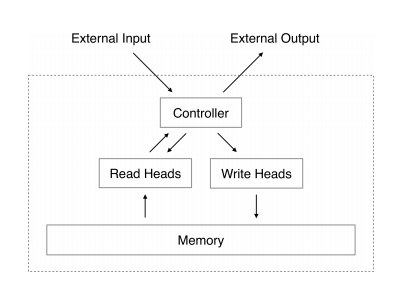Recently, DeepMind (Oops ! Google DeepMind) revealed a paper titled 'Neural Turing Machines'. Interesting name.
So, whats the deal here ? Basically, simple Neural Networks follow the following steps in their working lifetime :
- Learning using a given training data
- Prediction on new data
Suppose the idea is to make an animal image classifier. So, this step involves feeding the network with tagged images of various animals so that the network can learn what is what.

After training, we can feed an unknown image to the network and it will spit out its name to the best of its knowledge.
So far so good. What if we have a video and want to know whether an animal is running or jumping or walking (assuming it can't just stand still)? If I give you an image (a shot from video) of it with its four feet on the ground, can you say anything? Maybe not.

We need to know what the animal was doing before this image was captured. If the previous image had all its four legs in air, we can, with high probability, say that it is jumping, not walking. We just used our memory! If we can somehow store the last few sequence of actions, we can understand temporal patterns.
And it is important. Just remember how handy the pronouns are, if someone says "Pluto is not a planet" and then says, "It's back!" how could you have figured out what it is? By the way, are you listening a song right now?
We understand sequences, not snapshots.
Now there already is a kind of network that tries to store states, the Recurrent Neural Networks (RNN).
RNNs have feedback connections to make activation flow in loops (read wikipedia). This makes the system form a memory representation for current state of the network. Now the output of the network depends on current input as well as previous inputs which are helping the network to attain a state value. This helps it to be used in places where there are memory uses in understanding patterns.
1. NTM
A Neural Turing Machine (NTM) also tries to form a memory system, but it actually creates a separate memory outside the network (amazingly simple structure to look at), and the network does read and write operations on it.

In the above image, the controller is the actual neural network and it performs read and write on the memory via its read/write heads. (This structure results in the additional - 'Turing Machine')
The network can read and write to the memory by using a weight vector to control the amount of attention given to a place (content) in memory and is able to perform tasks of temporal nature. The exact method of implementing the interface between the controller (the network) and the memory is beautifully explained in the paper itself.
The paper can be found on arXiv here. It contains details on how to do read and write operations on the external memory from the controller, how the memory addressing works, and also a lot of interesting experimental results using NTM.